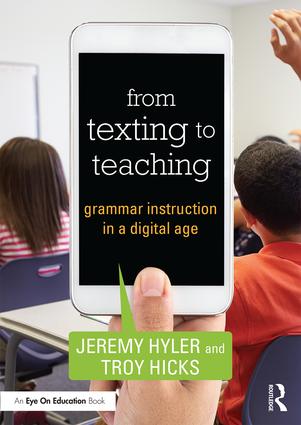New books about ed tech hit the market everyday, and it is sometimes difficult to find ones that truly meet the needs of teachers while being approachable and accessible. So, a few weeks ago, when I was tagged in a Twitter post about a new book, it definitely caught my attention:
What a great compliment from a teacher that our book is like Troy Hicks @hickstro for younger kids! @SolutionTree https://t.co/uCiCsbNY2F
— Katie Stover Kelly (@ktkelly14) April 28, 2017

Flattery aside, as an author and educator, I always appreciate shoutouts like these, and I was a bit dismayed that I had not yet heard about the book.
And, after a quick hop to the Amazon website where I previewed the book and read a review, I could tell that my own ideas about teaching reading and writing were, indeed, in line with those of Katie Stover and Lindsay Yearta.
With that knowledge in mind, I asked Stover if I could take a look at the book and, thanks to Solution Tree Press, my own copy arrived just a few days ago.
And, in much the way that Stover described the teacher’s endorsement in her tweet, I would certainly agree: From Pencils to Podcasts is a book that adopts the same stance toward reading, writing, and digital literacy that I, too, hope to imbue in my own work.
From the opening pages, the authors articulate their belief that “[t]echnology, when used intentionally, enhances teaching and learning as students have more opportunities to create, collaborate, communicate, and share” (6). I couldn’t agree more. Throughout the early pages of the introduction and into the fourteen chapters that follow, Stover and Yearta offer a variety of digital reading and writing tools that will be useful to elementary-level educators.

The book is segmented into four major parts. In part one, Stover and Yearta focus on tools to facilitate comprehension and analysis. Here, the authors provide many examples of teachers and students at work, as well as descriptions of the technologies that they employed. I was most intrigued by an example where a fifth grader and a college student discuss the shared reading using Edmodo. At one point in the dialogue, the college student records herself on video providing an additional response and clarification for her fifth-grade reading buddy (25). These types of small, yet powerful, examples are sprinkled throughout the book and demonstrate how readers and writers can flourish when supported through effective teaching and creative applications of technology. Also, Stover and Yearta provide links and QR codes throughout their book that lead directly to the apps/websites being mentioned, and they also have created a companion webpage with those links conveniently listed along with reproducible handouts.
In the second part, Stover and Yearta move on to discuss tools that can facilitate evaluation and revision. Again, the authors provide a number of different lesson ideas and technologies as examples, and one of the most unique twists is the application of digital video to the classic strategy of “reader’s theater.” They describe the ways in which students develop fluency as they engage in multiple readings of their selected book and, ultimately, produce and publish their own interpretation of the book using digital video (70).
The third section of the book offers even more opportunities for teachers to think about performance and publication as Stover and Yearta explore infographics, digital story retelling, publishing with a digital book creator, and incorporating speech-to-text dictation. Similarly, the fourth section pushes teachers to think creatively about new applications of existing technologies such as using timeline tools to create reading histories, conducting digital conferences using tools like VoiceThread, and composing digital portfolios with Seesaw or Weebly.
Additionally, throughout the book, Stover and Yearta share many case studies of teachers using tech in critical and creative ways. For instance, in the final chapter on formative assessment, they invite us into the classroom of Katharine Hale, exploring the ways in which she uses Lino and Padlet as spaces for students to capture their reading ideas, questions, and connections in-process.
On the whole, Stover and Yearta have designed and delivered a very useful book. My only concern is this: while the authors do present many examples from students and teachers, especially text-based examples such as digital discussion boards, as well as screenshots of the interfaces for various websites and apps, my one hope would have been to see more examples of student work, both in the book as well as through hyperlinks on the companion website.
For instance, Stiver and Yearta share overviews of many tools including infographics, digital movies, and a book creator app, yet the reader is left to her own imagination in order to visualize what these final products, created by students themselves, would actually look like. In other words, it would be helpful – especially for teachers new to digital reading and writing – to see even more examples of how students were able to utilize these tools in different ways, and to have them available online as mentor texts that teachers could click on and share in their own classrooms.
If a teacher is new to using 1:1 technology, the book offers numerous ideas that will be adaptable across grade levels. And, even if a teacher is familiar with many of the apps and websites, Stover and Yearta provide new insights into the ways in which these tools can be used. For any book that is written for teachers, it is a challenge to create a resource that is overflowing without being overwhelming, and with From Pencils to Podcasts, the authors have certainly accomplished their goal.
I am, indeed, flattered that a teacher has compared my work to theirs, and I appreciate their insights into the connection between emergent/early literacies and technology. For any K-6 educator who is new to using technology in her classroom – or wants to look at integrating technology with a fresh set of eyes –From Pencils to Podcasts should be on your summer reading list.
Disclaimer: At my request, I was provided with a free copy of the book by Solution Tree Press.

This work is licensed under a Creative Commons Attribution-NonCommercial-ShareAlike 4.0 International License.




 The past week has found me presenting to both pre-service teachers (three times!) and to fellow faculty (just once), and with each audience I shared the same activity: the
The past week has found me presenting to both pre-service teachers (three times!) and to fellow faculty (just once), and with each audience I shared the same activity: the 







